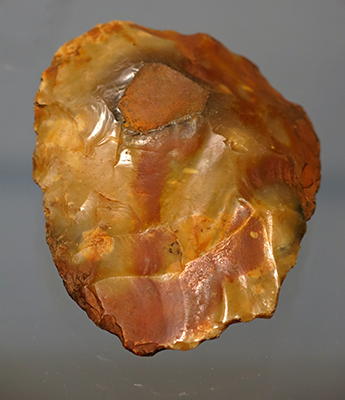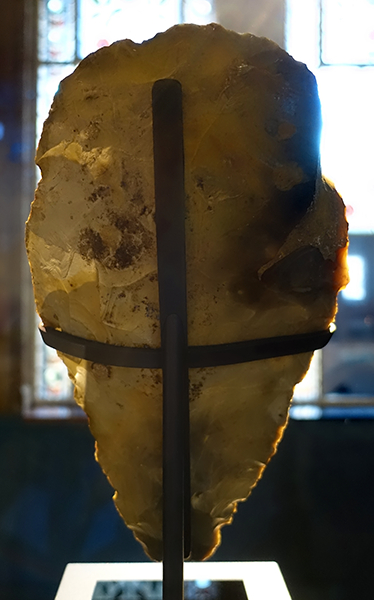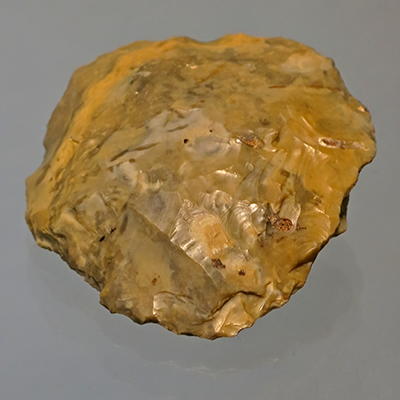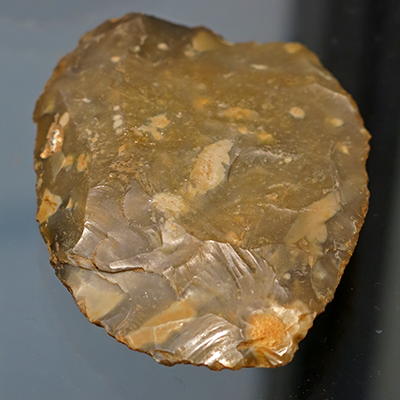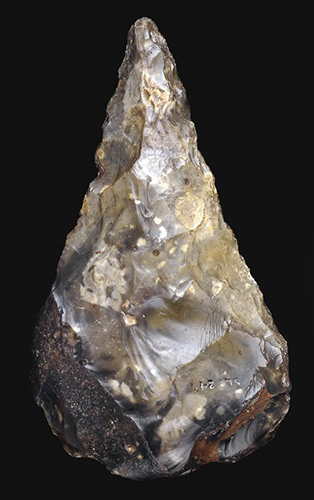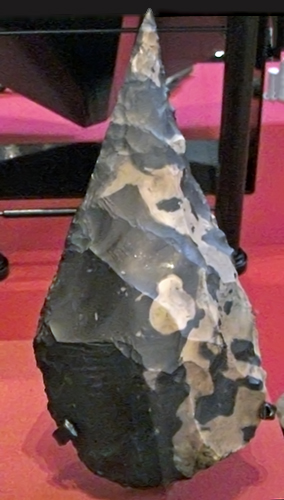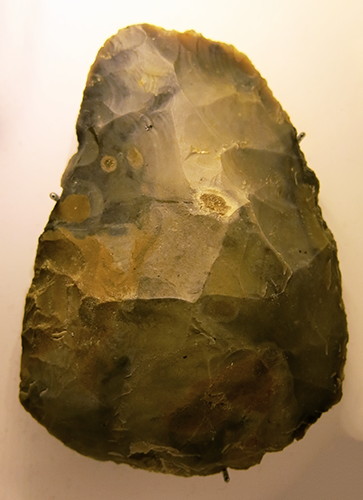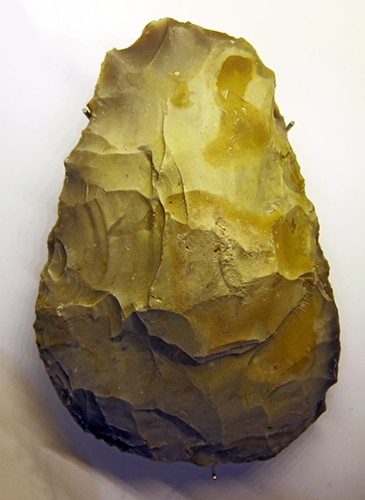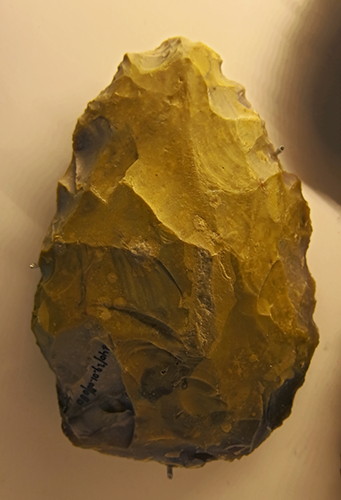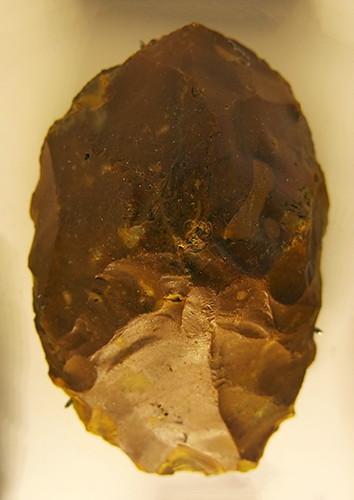Back to Don's Maps
 Back to Archaeological Sites
Back to Archaeological Sites
 Back to the review of hominins
Back to the review of hominins
 Back to Neanderthal Sites
Back to Neanderthal Sites

For a fuller discussion of Mousterian and Acheulean tools, readers should look at the page on tools.
I have reorganised and added to this page, to include sections specifically on the development of the ancient Acheulean hand axe by Homo erectus and the various types of this important tool, and the mastery of its creation by Homo neanderthalensis, who not only made it in the classic fashion, working on a core or nucleus bifacially, known as Moustérien de tradition acheuléenne or MTA, but also took flakes and turned them into bifacially worked Acheulean hand axes. There is a short summary of the development of such tools right through to Neolithic arrow heads, followed by a longer section on the step by step development of the full range of tools from choppers through to the bow and arrow.
British Mousterian and earlier tools and sites
Hand axes from Swanscombe, England, 1.5 million - 200 000 BP.
Photo: Don Hitchcock 2014
Source and text: Original, Københavns (Copenhagen) Museum, National Museum of Denmark
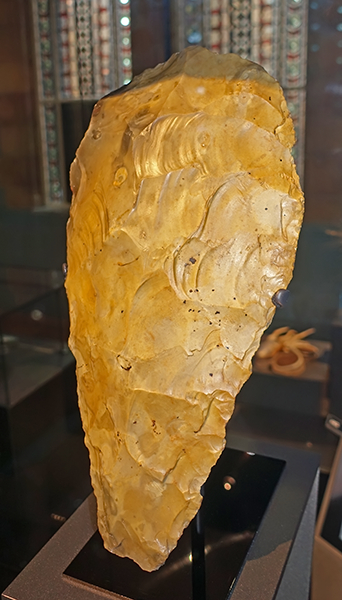
This is the largest handaxe ever found in Europe. It measures 32 cm long, and weighs 2800 g.
Its remarkable size, roughly twice that of other handaxes discovered, has raised questions about its purpose. Too large for practical use, it may have had a symbolic function, or been used as a status object, to demonstrate the skills of its makers.
The axe is remarkable for its symmetrical proportions, a clear indication of the high level of aesthetics amongst Neanderthals.
It was produced by the Acheulian culture of 400 000 years ago, during the Lower Palaeolithic period. It was found in Furze Platt, Berkshire, Britain in 1919.
Photo: Don Hitchcock 2018
Source and text: Original, display at The Natural History Museum, Cromwell Road, London SW7 5BD
Additional text: https://joyofmuseums.com/
Hand axes from Swanscombe, England, 1.5 million - 200 000 BP.
Photo: Don Hitchcock 2014
Source and text: Original, Københavns (Copenhagen) Museum, National Museum of Denmark
Acheulean Hand Axes
Lanceolate Profiles.
Left:
The Gray's Inn Lane Hand Axe is a pointed flint hand axe, found buried in gravel under Gray's Inn Lane, London, England, by pioneering archaeologist John Conyers in 1679. The hand axe is a fine example from about 350 000 years ago, from the Lower Palaeolithic, and probably made by Homo erectus, who made most of these sorts of hand axe.
Photo: © Trustees of the British Museum, CC BY-NC-SA 4.0
Source: https://www.britishmuseum.org/collection/image/10134001, © Trustees of the British Museum, CC BY-NC-SA 4.0
Right:
Another Acheulean hand axe was discovered by John Frere in the 1700s, when he investigated a four metre deep pit (dug by brickworkers) at Hoxne, in England.
Photo: Johnbod
Permission: Creative Commons Attribution-Share Alike 3.0 Unported license.
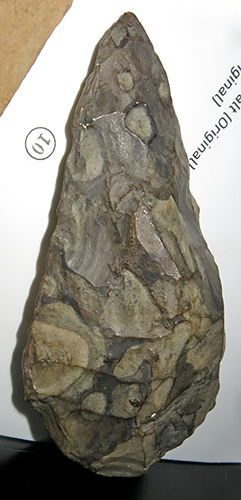
Acheulian hand axe, ca 400 000 BP, from Hoxne, England
Photo: Don Hitchcock 2015
Source and text: Facsimile, Monrepos Archäologisches Forschungszentrum und Museum, Neuwied, Germany

Acheulian handaxe probably used by Neanderthals.
From Swanscombe, Kent, England, around 400 000 BP.
( note that this handaxe appears to be of the Micoquien type, which is normally ascribed to a period of 130 000 BP - 60 000 BP - Don )
Catalog: E4190
Photo: Don Hitchcock 2018
Source and text: The Natural History Museum, Cromwell Road, London SW7 5BD

Flint Levallois core
( This is a beautiful piece, showing clearly the scar from the preparation and removal of a single classic levallois flake following circumferential preparation of the flaking surface. The flint appears to be fossiliferous - Don )
Circa 300 000 BP - 130 000 BP, Marine Isotope Stages 9 to 7.
From Baker's Hole, Kent, England.
The site of Baker's Hole in the Ebbsfleet valley, Kent, is the best-known British Early Middle Palaeolithic (MIS 9–7) site, and has produced a substantial assemblage of Levallois artefacts.
Photo: Don Hitchcock 2018
On loan from the Trustees of the British Museum
Source and text: Musée de l'Homme, Paris
Additional text: Scott (2010)
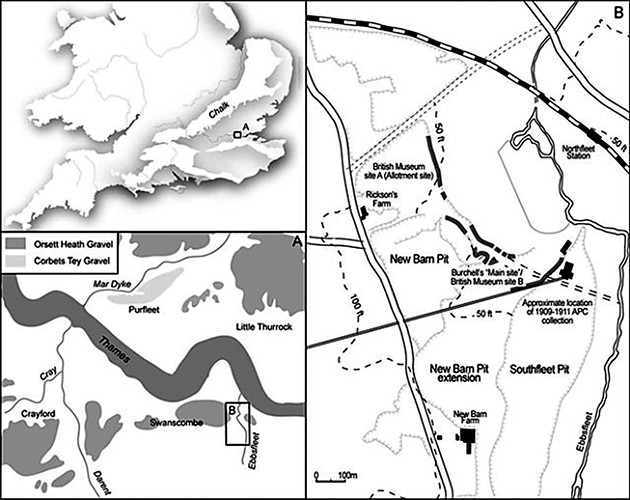
Baker's Hole is a 6.9 hectares (17 acres) geological Site of Special Scientific Interest, mostly consisting of a back-filled quarry, adjacent to Ebbsfleet International railway station in Kent.
At left is a location map showing the position of the Ebbsfleet Valley, in relation to mapped terraces of the Thames in area (A), as well as key positions investigated around Baker's Hole and the Ebbsfleet Valley (B).
Photo and text: Scott (2010)
Additional text: Wikipedia
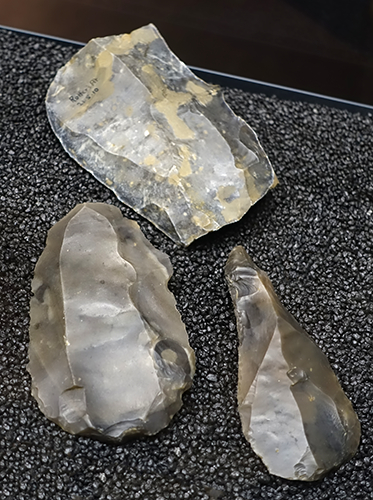
Levallois core, flake and point used by Neanderthals.
From Crayford, Kent, England, around 200 000 BP.
Catalog: E1430, E5986, E1004
Photo: Don Hitchcock 2018
Source and text: The Natural History Museum, Cromwell Road, London SW7 5BD

Four Neanderthal handaxes, recovered from the bed of the North Sea offshore from Yarmouth by dredging.
An amazing haul of 28 flint hand-axes, dated by archaeologists as around 100 000 years old, have been recovered off the coast of Norfolk.
The remarkable find was made by a Dutch amateur archaeologist, Jan Meulmeester, who sifted through gravel unearthed from a licensed marine aggregate dredging area 13km off Great Yarmouth and delivered to a wharf in southern Holland.
Reckoned to be the finest hand-axes that experts are certain come from English waters, the rare finds show that deep in the Ice Age, mammoth hunters roamed across land that is now submerged beneath the sea.
'These finds are massively important', said Ice Age expert Phil Harding of Wessex Archaeology and Channel 4’s Time Team. 'In the Ice Age the cold conditions meant that water was locked up in the ice caps. The sea level was lower then, so in some places what is now the seabed was dry land.'
Photo: Don Hitchcock 2014
Source: Original, Rijksmuseum van Oudheden, National Museum of Antiquities, Leiden, on loan from the Meulmeester Collection
Text: http://www.culture24.org.uk/history-and-heritage/archaeology/art55043
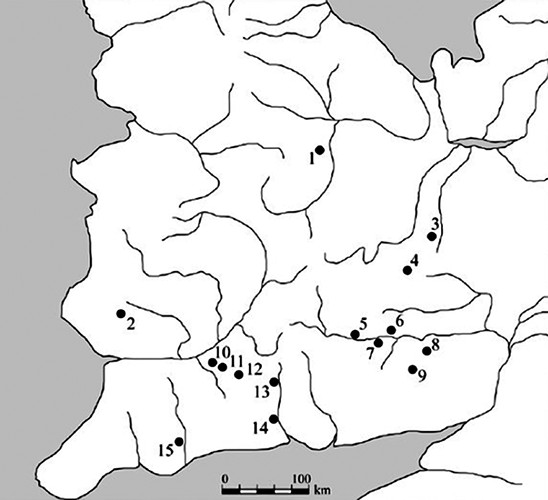
Locations of British Mousterian sites with bifaces/biface thinning flakes.
The landmass is shown with approximately -50m sea levels, circa 50 000 BP.
1: Creswell locales, including Robin Hood Cave, Pin Hole, Mother Grundy’s Parlour, Ash Tree Cave
2: Coygan Cave
3: Lynford Quarry and Saham Toney
4: Little Paxton
5: Marlow
6: Berrymead
7: Sipson
8: Snodland
9: Oldbury
10: Uphill Quarry
11: Picken’s Hole
12: Hyaena Den and Rhinoceros Hole
13: Fisherton
14: Castle Lane and Southbourne
15: Kent’s Cavern.
Photo and text: Wragg (2010)
Bout coupé biface handaxes
Bout coupé characteristics:
• rounded tip
• two slightly convex lateral edges
• cutting edge worked around the entire circumference
• a very low position of maximum width
• two clear angles at the intersection of the butt and lateral margins
• straight or slightly convex butt edge
Text above: Karen et al. (2016)
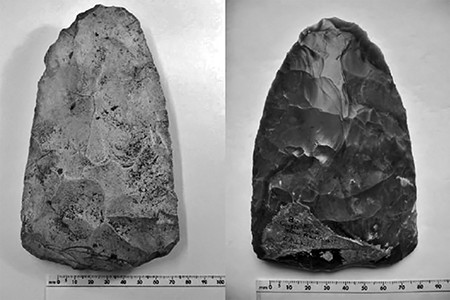
The two most classic (or extreme) examples of bout coupés.
Left: Coygan Cave; right: Castle Lane, Bournemouth.
Photo and text: Wragg (2010)
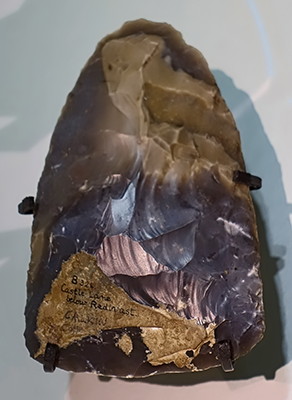
Bout coupé biface flint handaxe
Circa 71 000 BP - 57 000 BP
Marine isotope stage 4, a cold glacial period.
Catalog: B324, Castle Lane below Redbreast, Bournemouth
Photo: Don Hitchcock 2018
On loan from the Trustees of the British Museum
Source and text: Musée de l'Homme, Paris
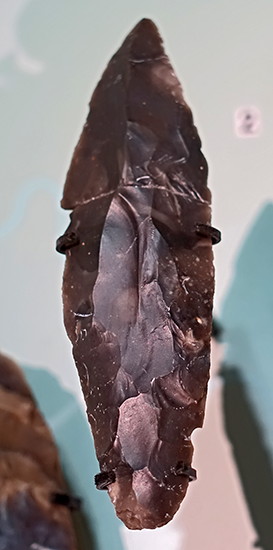
Flint point
Circa 57 000 BP - 35 000 BP, Marine isotope stage 3, a warm glacial period.
From: Beedings, south-eastern England.
This piece is from a collection of lithic artefacts unearthed during the building of a house called Beedings on a scarp crest near Pulborough in West Sussex.The discovery was probably made in 1900. The collection is very obviously multi-period, but it includes the largest group of Early Upper Palaeolithic artefacts from south-eastern England. Attributed to this time are leaf-points, end-scrapers, and burins.
While recent selection has much reduced the collection it also appears to contain contemporary cores and debitage and evidence for the production of bladelets. In a British context this find is unique and in a European perspective it is one of the richest assemblages attributable to the Lincombian–Ranisian–Jerzmanowician technocomplex.
The age of this technocomplex is poorly constrained, but Jacobi (2007) argue that it belongs to the earliest part of the Upper Palaeolithic, starting earlier than the local Aurignacian. The Upper Palaeolithic material from Beedings is interpreted as having come from a hunting camp situated so as to exploit the extensive views across the western Weald.
Photo: Don Hitchcock 2018
On loan from the Sussex Archaeological Society
Source and text: Musée de l'Homme, Paris
Additional text: Jacobi (2007)
References
- Jacobi, R., Debenham N., Catt J., 2007: A Collection of Early Upper Palaeolithic Artefacts from Beedings, near Pulborough, West Sussex, and the Context of Similar Finds from the British Isles, Proceedings of the Prehistoric Society, Volume 73 2007 , pp. 229-326.
- Karen R., Rebecca M., Wragg S., 2016: Spatio-temporal variation in late Middle Palaeolithic Neanderthal behaviour: British bout coupé handaxes as a case study, Quaternary International, Volume 411, Part A, 8 August 2016, Pages 305-326
- Scott B., 2010: The investigation of Baker's Hole, Northfleet, Kent, 1909–1914; the impact of collection history upon the interpretation of archaeological data, Proceedings of the Geologists Association, 121(1):77-82, DOI: 10.1016/j.pgeola.2010.02.006
- Wragg, R., 2010: Beyond bout coupés: the dynamic role of bifaces in the British Mousterian, Lithics, The Journal of the Lithic Studies Society 31: 20–32.
Back to Don's Maps
 Back to Archaeological Sites
Back to Archaeological Sites

